On 17 October 2023, at 18:59 local time an explosion took place in the parking lot of the courtyard of al-Ahli Arab Hospital in Gaza City. The consequence was a large number of fatalities and injuries. What happened on the side was something expected — heated discussions, accusations, and blaming either side. The difficulties of the ongoing war and the still-functional hospital further obstructed any site investigation, so what is left is to use as many sources available online to at least try to build a picture of some of the possibilities of what might have happened that night.
This article (part 1) is an attempt to take a step back, have an unbiased approach, and present some of the facts and hypotheses. It will address bomb scene investigation, theoretical and technical aspects of the explosion, and its effects. It will also examine two hypotheses which are the "most used" in media:
Hypothesis 1 - the bomb, and
Hypothesis 2 - the stray rockets.
Introduction
Bomb scene investigation basis
Bomb scene investigation is very complex. If that has to be performed during an ongoing war it gets more complicated. The Gaza hospital attack is one of the most complicated sites to perform an investigation because it is an active hospital and it is impossible to isolate the area without interrupting its functioning. Also, the availability of skilled and unbiased investigators at the site is almost nil.
As soon as the bombing happened both sides in the conflict, without any surprise, issued their versions. The tension is high and the emotions are high as well. The public is polarized, with the Palestinian claim that the Israeli bombing theory is widely accepted and, on the contrary, the Israeli claim (that it was a stray Hamas rocket) being pushed through its PR service, accepted by Western media, and supported by Western politicians. But, what really happened that night that caused devastation at al-Ahli Hospital?
This article is going to explain multiple options but ultimately is not going to finger-point to anyone...yet...
How to properly perform the bomb site investigation
In this section, the typical bomb site investigation is explained. It is more or less universally accepted. The reader should bear in mind that some crucial steps in the Gaza bomb investigation couldn't be performed so, for now, the majority of information comes from videos and online sources.
So, lets dive into the bomb scene investigation: When responding to a call to the scene of an apparent explosion, the investigator is required to have a working knowledge of a diverse set of disciplines. These include the ability to assess the incident to determine if, in fact, there has been an explosion and to identify the type of explosion; investigate the scene for evidence; identify bomb components; and recognize and document the dynamics of the explosion. The dynamics of the explosion involve what occurs when an explosive is initiated and the results of that initiation. In other words, given a quantity of explosives and a suitable method of initiation or fusing system, when an explosion occurs, what are the observable physical results? This explanation or knowledge assists the investigator immeasurably in understanding what he or she sees at the site of an explosion. This is acceptable both in military and civilian investigations.
The bombing investigator begins with the result - fragmented debris and the devastation at an explosion site - and must work in reverse to understand not only the event that caused the scene but also how it occurred. An understanding of explosion theory and dynamics will assist the investigator in forming a theory or hypothesis in the search for these answers. To be sure, even with an understanding of explosion dynamics, there will be times when the effects of a bombing are difficult to understand, or defy an explanation.
Immediately after the explosion, there were some videos showing that some kind of the site and in particular the crater investigation and claiming that the Palestinian EOD team is involved.
Unfortunately, due to the high traffic, it was impossible to isolate this area and execute a full search and collect all metal debris.
Scientific Method[1]
With regard to investigating a bombing crime scene or, for that matter, any investigation, a problem-solving model should be identified, understood, and utilized. The “scientific method” is such a model in that it provides a systematic approach to solving a problem.
The scientific method has seven identifiable steps: (1) identify that a problem exists; (2) define the problem; (3) collect empirical data; (4) analyze the data through inductive reasoning; (5) develop a hypothesis; (6) test that hypothesis through deductive reasoning, and (7) examine the conclusions and determine the course of action or the cause of the incident[1].

Let’s go to Figure 2:
Step 1 components, namely, “protect the scene and access resources”, can’t be performed at the Gaza site because these two fundamental things can’t be achieved because of the the chaotic situation and 24/7 operation of the hospital.
Step 2 can be performed, or at least to be improvised. It can be done on- or off-site.
Step 3 can be performed based on the visual evidence such as videos and photos to some level, but the bomb scene is contaminated and any search and collection of evidence is almost impossible without isolating the site. This includes a crucial search for any bomb or rocket debris or fragments that may be scattered around. Any nametag, part of the stabilizer, control etc. can help in identifying the source. The identification can be performed online with enough sources but collecting the evidence can be performed only at the location.
Step 4 is theoretical and based on the best knowledge of the investigator. This is the place where, in social media, you will see hundreds of different theories — in the majority of cases biased.
Step 5 is where the serious investigator starts to differentiate from the ever-present charlatanism.
Steps 6 and 7 are the ones that depend on a thorough investigation, and they are time consuming processes.
Before any investigation can begin, there must be an incident report or a report of an explosion made by a professional. Journalists and casual observers are not in this group but to some degree their observations may be used. In practice, the first responder or investigator does not know if the report is correct or not; so, he or she will go to the reported scene to determine whether there is a problem. In some instances, this may not be as easy as one would believe, and in this case it is almost impossible. However, in this case, it is evident that there has been an explosion, and the steps to be followed by the investigator are as follows:
The problem needs to be defined; that is, what type of explosion was it – the detonation of an explosive either through the bomb, rocket, or missile and/or fire of the unspent rocket fuel?
Empirical data (based on an investigator’s observation and experience) need to be collected from the scene by examining or looking at the scene and conducting interviews. These data would include the physical characteristics present at the scene as a result of the explosion.
The information collected is then analyzed by inductive reasoning or in the light of the investigator’s knowledge, training, and experience.
After the information is analyzed, it is possible to formulate a theory or a hypothesis to explain what happened. This hypothesis cannot be based on speculation, hunches, or perceived facts, but only on the empirical data collected and analyzed by the investigator.
In this case, the characteristics observed at the scene are indicative but not conclusive, at this point, of an explosion from a bomb or a rocket. The investigator now tests the hypothesis that it was a bomb by considering all the other logical causes of the explosion. This deductive reasoning can be performed by the use of cognitive skills or by experimentation, such as actual testing. Essentially, the investigator looks at all the information collected and compares it with the hypothesis. Do the collected facts meet the criteria of a bomb rather than those of the detonation of a rocket?
If the answer to the question posed in the previous list item is yes, then the conclusion is reached that the explosion was, in fact, a bomb. If the hypothesis cannot be supported by testing or deductive reasoning, then a new hypothesis must be formulated. This new hypothesis could be based on a reanalysis of existing data or the collection of new or additional data, and an analysis of those data. The process is repeated until a conclusion is reached that can withstand testing and examination.
Explosion theory
The following is a brief lecture about explosions that may help readers understand what kind of effects an explosion can produce at the site.
Explosion Effects on Targets
The impact of explosive munitions can be broken down into the principal damage mechanisms and their primary effects, and the secondary and tertiary effects occasioned by them. This section focuses on the primary damage mechanisms and secondary effects of explosives.
The primary effects of explosive weapons are defined as those “caused directly by the destructive effects that radiate from a point of initiation, and include blast overpressure, fragmentation, heat, and light.” These are attributed directly to the principal damage mechanism of an explosive weapon — blast, fragmentation, and heat. The term “blast” refers to a high-pressure blast wave moving at supersonic speed, referred to as the shock wave, which is followed by blast winds. Primary fragmentation is comprised of fragments that originate directly from the explosive munition. The third damage mechanism is the thermal energy released during detonation of the explosive.
Most high-explosive warheads are not designed to deliver an augmented incendiary effect and the thermal effect is limited to the immediate area of the detonation, primarily because of its extremely short duration. Generally, the primary thermal hazard posed by an explosive weapon is less significant than the blast and fragmentation threats. Secondary effects of explosive weapons derive from the environment in which the munition detonates. The most significant secondary effects include secondary fragmentation, firebrands, ground shock, and cratering. Secondary fragmentation originates from objects that have been affected by the detonation and can include such objects as pieces of masonry or glass from structures, or bone fragments from human or animal targets.
Secondary fragments are generally larger than primary fragments and tend not to travel as fast, or as far. Ground shock results from the energy imparted to the ground by the shock wave caused by an explosion, and can result from a detonation under or on the ground, or in the air above.
Ground shock poses an additional threat to the structural integrity of buildings (which has significant effect in the urban areas), as the ground conducts the shock wave into the foundations and walls.
Blast Effects
An explosive is a material that is capable of producing an explosion by releasing the potential energy contained within it. All high explosives produce heat and gas. When a high-explosive charge detonates, it produces a blast wave (overpressure) that consists of two parts: a shock wave and a blast wind. The blast wave pushes outward from the core of the detonation at supersonic speed. The outer edge of the blast wave is made up of the compressed gases contained in the surrounding air. This layer of compressed air is more properly described as a shock wave or shock front. In open air, the blast decays extremely quickly with time and distance; typically it can be measured in milliseconds.
The blast wave has two phases. The positive-pressure phase pushes a large portion of the surrounding air away from the core of the detonation at supersonic speed, leaving a broad partial vacuum behind it. When the blast wave of the positive-pressure phase loses momentum, the partial vacuum behind it causes the compressed and displaced gases to reverse their movement and rush inward to fill the void. The negative-pressure phase moves less quickly than the positive phase and it generally lasts approximately three times as long.
The effect of the pressure wave upon a structure depends on what the structure is composed of and how it is built. In essence, it is dependent upon the structure’s natural frequency of vibration compared with the duration of the blast wave. When the supersonic shock front from a detonation encounters a solid structure, some of the energy is reflected, and some of the energy is transmitted into the structure; the relative amounts depend on the properties of the structure.
In the process of striking the target, the shock front will impart significant momentum to the exterior components. These components will be pushed towards the interior by the positive-pressure wave, straining the resisting elements of the structure (such as support columns, building facades, etc.). Some of those resisting elements, windows in particular, will fail. As the negative-pressure phase of the pressure passes back through the structure, the direction of the energy is reversed. Unlike the reflection of sound waves, which have a negligible effect on the medium through which they are travelling, shock waves are moving at such high speed and contain so much energy that they change the medium itself. When the shock wave hits the ground, it is reflected back into the still-advancing blast wind. This amplifies the blast overpressure anywhere up to twenty times that of the initial detonation.
Fragmentation
Primary fragmentation originates from the casing of the metallic shell surrounding the high explosive charge. Fragments can take a variety of shapes and sizes and are primarily effective in an anti-personnel capacity. The type of steel used in the manufacture of the artillery shell plays a significant role in determining the nature of the natural fragmentation that is produced. High-explosive shells are typically made from either forged or cast steel or iron. Cast metals are melted down and poured into molds to form the shape of the projectile, whereas forged steel projectiles are formed by beating red-hot steel ingots into the desired shape. MLRS rockets have the thinner pre-formed shells or tight-packed cubes to reduce the weight. The same is true of anti-aircraft missiles where the primary defeating elements are fragments.
Calculating the effects of primary fragmentation is more complicated than the blast effect, owing to the number of known unknowns. In many cases, the initial velocity (speed and impact angle) of the shell at the time of detonation is not known, nor is the exact shape, weight, and aerodynamic performance of each fragment. The type of fuze will also affect the fragmentation pattern. Due to the greater variation in the size and number of fragments caused by the explosion, natural fragmentation is more difficult to predict and model. The effect of fragmentation on human targets is particularly unpredictable, as the amount of exposed body area and the posture of the target can have a marked influence on the potential harm.
The angle at which a munition impacts the target has a significant bearing on the size and shape of the lethal area. In simple terms, the higher the angle (toward vertical 90°) of the fall, the larger the lethal area will be. In order to maximize the lethal area, at higher angles of fall (45–90°) the optimal height for detonation is approximately 2m above ground, although even at just above the ground, the lethal area is increased.
Spalling presents an additional danger in urban environments. It is a stress-wave effect most commonly observed in materials more brittle than metal. This occurs when an impact strikes the outer surface of a solid body, causing fragments to break off from the inside surface. The projectile or the fragment does not need to penetrate the solid body; merely striking the outer surface with sufficient energy may result in spalling. A possible scenario resulting in spalling is a brick wall being struck by a blast wave, or in some cases a projectile or a sufficiently energetic fragment, causing secondary fragmentation inside the building. A significant hazard unique to urban environments is the risk of fatally compromised structural integrity of buildings caused by the blast waves. Any people in and around those buildings and structures may be crushed by their partial or complete collapse.
Explosion Signature - Cratering
Cratering refers to the buckling and deformation of the ground around the detonation point. Both ground shock and cratering can cause substantial damage to underground shelters and bunkers as well as critical infrastructure. This may be a deliberate effect of explosive munitions optimized for cratering, intended to obstruct avenues of approach or to disrupt infrastructure. An impressive aspect of a surface explosion is its resulting crater. The great variability in crater formation is indicated by standard deviations of about one-third the diameter given by equation in the picture above. The depth of the crater created by an explosion is ordinarily about one-quarter its diameter, but this depends on the type of soil present. The diameter of the crater from an explosion also depends on the location of the explosion relative to surface level. Thus, explosions above a surface may not create any crater at all. For explosions below the surface, crater diameter initially increases with depth of explosion, reaches a maximum, then decreases substantially.
There is a comparatively good correlation between crater radius and sympathetic detonation distance, an observation that confirms the thought that sympathetic detonation is affected by the tangible physical means of missile or fragment impact.
The illustration above is typical for on the ground and underground explosion, but for the above-ground explosions it is a bit different. For the above-ground explosion, often there is no characteristic crater or it is the small one (which depends of the height of the air burst) and what will be visible is a compression.
Analysis of the explosion at the hospital in Gaza
Hypothesis, facts and evidence
There are few facts that are undoubtful and easy to find online:
Whistling/high pitch sound and explosion
Fire
Large number of casualties
Destroyed and damaged vehicles
Some damage to the surrounding buildings
Small crater
Video and photo records made by Palestinians and Israelis as well as media present
At first glance, this would be sufficient to do analysis and get clues, but in reality it is far from that.
Whistling/high pitch sound and explosion
The first evidence of the bombing was a video that shows large explosion and fire. What is interesting in that video is a sound. A sound of high velocity object approaching and exploding loudly. Also there is a background sound with more or less constant intensity. This noise may be associated with an engine noise.
These two noises are important evidence, but they are not crucial in determining what hit the hospital. The size of fire can be deceiving because during night conditions, the contrast of the bright illumination from the dark background seems a bit larger than it is during daylight.
The high pitch noise is certainly from either a bomb, missile, or rocket. There are differences between these three: Missiles are powered by an engine, either a type of rocket engine or jet engine and can have guidance. Israelis are using variety of sophisticated missiles. Rockets are powered generally with a solid-propellant fuel or makeshift mixture liquid fuel. Hamas is making this in the local shops. Reliability of the Hamas rockets is questionable at least because from time to time they deviate from ballistic trajectories randomly. Bombs are typically not powered (they don’t have a propulsion unit) and can be guided or unguided. Israel is a sole user of this type of ammunition. The doppler effect in the sound frequency change is associated with an aerial approach.
Fire
The fireball is visible immediately after the explosion. The size of the fireball and consequent fire may point in the direction of a near-the-surface explosion, or a smaller amount of explosive material. A surface hit or ground penetrating bomb will create more smoke and debris but will also create fire as well. This is random behavior and depends on what target was hit, including flammable materials. In the case of explosion of ammunition, flammable materials will multiply the size and effect and also it will show secondary explosions, which are not seen in this case.
Large number of casualties
The number of persons killed in the explosion has not been independently verified, Gaza Health Ministry stated 471 killed. U.S. intelligence agencies had assessed that the blast killed 100 - 300 people. Even though the number is disputed, it is still a huge tragedy.
Destroyed and damaged vehicles
Explosion left a number of destroyed and damaged vehicles.
One vehicle is flipped and numerous completely burned with visible damage either due to the blast, fire, or fuel explosion. Some have shrapnel damage. This will be discussed in the following sections.
Small crater
What was surprising is that after the very loud explosion during the night, the expectation was that the crater would be large, which is typical for Israeli used ordnance that targets underground tunnels and bunkers, and are used to bring down whole buildings. However, the size of the crater was actually relatively small. This created a lot of additional questions.
This small crater was used to push the narrative that it was a Hamas stray rocket and this is based on the numerous photos of similar damage in some Israeli locations. However, this is not a definitive reason to immediately “identify” the perpetrator. The whole picture must be examined at every angle.
It is known that small rockets, artillery shells, and and mortar mines can leave smaller craters. There is also a possibility that during the air burst, the fuze which is usually located in the bomb or rocket nose can be ejected and hit the ground in the direction of flight and, due to the velocity and angle, can make a crater.
For the artillery and mortar shell there are methods to determine the location of the launch. Some of these methods can be applied also for rockets. But there is a catch: the rocket can randomly deviate from a ballistic trajectory (flip, turn, etc.) and hit the ground in almost any direction (with the higher probability that it will hit from the direction of launching but that is not always the case).
What does this mean for the investigator?
Investigation of artillery craters is well covered in manuals. For the sake of another exercise in determining the Gaza bombing, let's describe some site examination methods based on the field manuals and diagrams. These are related to surface explosions but to some degree, they can also be applicable to air bursts.
US Army field manual FM 3-09.12 (6-121) has an appendix addressing craters. Among the standard artillery ammunition craters made by shells and mortar mines, it also deals with the rocket impact crater.
A rocket crater resulting from a rocket impacting with a low or medium angle of fall is analyzed in the same manner as an artillery crater resulting from a projectile armed with a quick fuze . However, if the rocket impacts with a high angle of fall, the crater is analyzed in the same manner as a crater resulting from a mortar round fired with a quick fuze. The tail fins, rocket motor, body, and other parts of the rocket may be used to determine the caliber and type of rocket fired. At the Gaza site, for now, no tail fins, no fragments of the body, or any other parts that can help were located.
As time passes, there is less chance that something will be found because the site is toured by many, so regarding the investigation it can be considered as "contaminated".
Low-angle quick fuze craters
The detonation of a low-angle quick fuze projectile causes an inner crater. The burst and momentum of the shell carry the effect forward and to the sides, forming an arrow that points to the rear (toward the weapon from which the round was fired). The fuze continues along the line of flight, creating a fuze furrow. There are two methods of obtaining a direction to a hostile weapon from this type of crater. These are the fuze furrow and center of crater method and the side spray method. The best results are obtained by determining a mean, or average, of several directions obtained by using both methods.
How to address the high-angle impact: In a typical high-angle mortar crater, the turf at the forward edge (the direction away from the hostile mortar) is undercut. The rear edge of the crater is shorn of vegetation and grooved by splinters. When fresh, the crater is covered with loose earth, which must be carefully removed to disclose the firm burnt inner crater. The ground surrounding the crater is streaked by splinter grooves that radiate from the point of detonation. The ends of the splinter grooves on the rearward side are on an approximately straight line. This line is perpendicular to the horizontal trajectory of the round. A fuze tunnel is caused by the fuze burying itself at the bottom of the inner crater in front of the point of detonation. Three methods may be used to determine direction from a high-angle mortar shell: crater-main axis, splinter groove, and fuze tunnel.
What that visually mean is shown in the pictures.
With the previously mentioned crater analysis, and with the use of measuring instruments, to a certain degree the direction of the approach can be determined. But this creates another question: If, for example, a rocket during the ballistic trajectory somehow flips in the air and changes direction, like stall, it can theoretically hit the ground on quite opposite angle from the azimuth of launch. In this case, the direction of the launch can be wrong.
Hypothesis 1 - the Bomb
A bomb dropped from some altitude (that would be above 3000 m for Gaza conditions) will initially have a speed of the launching platform. In the case of a guided bomb, after drop, it will continue to the designated target with a steep dive that may produce a high-pitched noise. This noise depends on the bomb's aerodynamic shape, diameter, length, air flow, angle of dive, initial velocity, and terminal velocity, to name a few. For an observer, a Doppler effect will play a role depending on where the observer is positioned.
With this hypothesis, if the bomb is the perpetrator, then what kind of bomb may be involved?
Was that a Joint Direct Attack Munition (JDAM), laser-guided bomb, or ordinary gravity bomb?
Was the bomb small or large?
Was that ground- or air-burst activation (with a proximity fuze)?
These are questions that the investigator must answer.
The following illustration shows what kind of JDAM bombs are in the US and the IAF arsenal:
2,000 lb (900 kg) nominal weight
GBU-31(V)1/B (USAF) Mk 84
GBU-31(V)2/B (USN/USMC) Mk 84
GBU-31(V)3/B (USAF) BLU-109
GBU-31(V)4/B (USN/USMC) BLU-109
GBU-31(V)5/B (USAF) BLU-119/B
GBU-31v11: Guided BLU-136 cluster bomb replacement
1,000 lb (450 kg) nominal weight
GBU-32(V)1/B (USAF) Mk 83
GBU-32(V)2/B (USN/USMC) Mk 83
GBU-35(V)1/B (USN/USMC) BLU-110
500 lb (225 kg) nominal weight
GBU-38(V)1/B (USAF) Mk 82 and BLU-111
GBU-38(V)2/B (USN/USMC) Mk 82 and BLU-111
GBU-38(V)3/B (USAF) BLU-126/B
GBU-38(V)4/B (USN/USMC) BLU-126/B
GBU-38(V)5/B (USAF) BLU-129/B
GBU-54/B Laser JDAM Mk 82
To further develop and explore this hypothesis, let's check the bomb site and see what kind of damage a JDAM bomb can inflict: The first thing is the blast but the way a bomb scene looks may indicate that it wasn't a big JDAM (packing 900 or 450 kg explosive) but rather something smaller. The list of the suspects can be narrowed now. That may be something in the range of 500 lb or 225 kg nominal weight, eliminating the heavier ones.
Below is a US-made JDAM bomb for the sake of comparing the noises from the previous video.
So the first hypothesis is that it was an object (supposedly a JDAM bomb) based on the similarities between the background noise and the whistling high-pitch noise in both videos.
For this hypothesis, we can rule out the surface burst because the crater is too small for any of that.
Let's assume that is a low-yield or small bomb of up to 250 kg weight and with a proximity fuze to activate the bomb at a certain distance above the ground.
Is this kind of bomb available in the Israeli Air Force arsenal? The answer is yes. They have JDAM and small diameter bombs (SDB) which are made in the USA as well as some domestically developed models.
Let's now expand the bomb theory with small-diameter bombs or SDBs. In this group, there is one model, the GBU-39/B SDB is a 250-pound (110 kg) precision-guided glide bomb that is intended to provide aircraft with the ability to carry a higher number of more accurate bombs. Israeli F-15I can carry (using the BRU-61/A rack) a pack of four SDBs in place of a single 2,000-pound (910 kg) bomb.
According to Boeing web page GBU-39/B
GBU-39/B Weapon:
Dimensions: (L x W): 70.8" x 7.5" (1.8 m x 19 cm)
Weapon Weight: 285 lbs. (130 kg)
Warhead: 206 lb. (93 kg) penetrating blast fragmentation
Warhead penetration: >3 feet of steel reinforced concrete
Fuze: electronic safe/arm fuze (ESAF) cockpit selectable functions, including air burst and delayed burst options
Standoff maximum range: more than 60 nautical miles
Precision inertial navigation system/global positioning system (INS/GPS)
Anti-jam GPS and selective-ability anti-spoofing module (SAASM)
BRU-61/A Carriage System:
Payload capacity: four weapons
Weight: 320 lbs. (145 kg) empty, 1,460 lbs. (664 kg) loaded
Dimensions (L x W x H): 143" x 16" x 16" (3.6 m x 40.6 cm x 40.6 cm)
Wikipedia also describes :
GBU-39A/B – SDB Focused Lethality Munition (FLM)
Boeing developed a version of the SDB I which replaces the steel casing with a lightweight composite casing and the warhead with a focused-blast explosive such as a dense inert metal explosive (DIME). This should further reduce collateral damage when using the weapon for pin-point strikes in urban areas.
GBU-39B/B – Laser SDB
With the delay in GBU-53/B SDB II fielding, Boeing recommended an upgrade to their SDB as a temporary bridge to get the desired performance at a fraction of the cost. Called the Laser Small Diameter Bomb (LSDB), it integrates the laser used on the JDAM to enable the bomb to strike moving targets. Boeing says the LSDB will use the same semi-active laser sensor as the JDAM to hit moving and maritime targets.
Israel purchased several thousand of these bombs.
The SDB bomb has integrated "Diamond Back" type wings which deploy after release, increasing the glide time and therefore the maximum range. Its size and accuracy allow for an effective munition with less collateral damage. Besides the "classic" penetration ability, this bomb has a fuze with pilot selectable functions, including air burst and delayed options.
What is also interesting about this SDB FLM bomb is that it uses a lightweight composite casing and the warhead with a focused-blast explosive such as dense inert metal explosive (DIME). The main advantage of this composite application is reducing the collateral damage when using the weapon for pinpoint strikes in urban areas. According to available data, warhead weight is 137 lb (62 kg) AFX 1209 MBX ("multiphase blast explosive") in the composite case. LSDB (GBU 39B/B) has 36 lb (16 kg) AFX 757 enhanced blast insensitive explosive, penetrating steel case and SDB I (GBU-39/B has AFX insensitive munition certified PBX explosive fill weighting 36 lb (16 kg).
A DIME weapon consists of a carbon fiber casing filled with a mixture of explosive and very dense micro shrapnel, consisting of very small particles (1–2 mm) or powder of heavy metal. Upon detonation of the explosive, the casing disintegrates into extremely small particles, as opposed to larger pieces of shrapnel which results from the fragmentation of a metal shell casing.
For illustration example, F-15I "235" (assigned to 69 Squadron "The Hammers"), with 250 lb class GBU-39/B or GBU-39A/B FLM affixed to a BRU-61/A four-place smart carriage system.
At this moment, if the surface burst is put aside (for now) the hypothesis development shall be focused on the air burst.
Air burst
This is just a non-scaled graphic that presents the aerial burst of a spherical charge. On the ground, depending on the explosive charge, the height of the burst, and the angle of approach, the crater may be small with little or almost no material ejecta.
That shock wave can be created by the air burst. In this case, the initial shockwave will create the damage which greatly depends on the explosive charge and geometry of impact. The initial shock wave will bounce from the harder media such as the ground and travel in the opposite direction, which can flip loose objects on the ground. The impact of the shock wave on the ground can create enough pressure to turn all loose objects into shrapnel that can be randomly scattered. The secondary, bounced shock wave can propel these shrapnel to velocities high enough to punch through cars, walls, or humans. The blast will shatter closed windows but may not affect the open ones because the pressure will be passing into the interior. During the explosion, basically, three characteristic zones are formed on the ground: compression zone - destruction zone - shock zone The shock zone is the widest one. The compression zone is a small one and may create some kind of crater that is different in size from the one created during the surface explosion or underground explosion.
Blast pressure exercise
For the sake of exercise and to have a feeling about the blast wave that can be created using, for example, an SDB FLM (GBU-39A/B) bomb that has a composite body and about 62 kg of explosive charge, and using the Kingery-Bulmash equation and blast parameter calculator (which provides data for incident pressure, reflected pressure, incident impulse, reflected impulse, duration of positive pressure phase, time of arrival of the shock wave, and shock front velocity, combined with the desired blast altitude), some parameters can be estimated. The explosive taken into consideration is HMX, while the SDB uses AFX 1209 MBX
15 m:
TNT Weight for Pressure (kg):63.24
TNT Weight for Impulse (kg):63.86
Incident Pressure (kPa):72.95
Incident Impulse (kPa-ms):303.95
Reflected Pressure (kPa):186.73
Reflected Impulse (kPa-ms):690.21
Time of Arrival (ms):20.91
Positive Phase Duration (ms):13.24
Shock Front Velocity (m/s):433.27
10 m:
TNT Weight for Pressure (kg):63.24 TNT
Weight for Impulse (kg):63.86
Incident Pressure (kPa):170.01
Incident Impulse (kPa-ms):434.88
Reflected Pressure (kPa):541.33
Reflected Impulse (kPa-ms):1105.92
Time of Arrival (ms):10.30
Positive Phase Duration (ms):0.00
Shock Front Velocity (m/s):531.48
5 m:
TNT Weight for Pressure (kg):63.24
TNT Weight for Impulse (kg):63.86
Incident Pressure (kPa):826.29
Incident Impulse (kPa-ms):827.70
Reflected Pressure (kPa):4299.15
Reflected Impulse (kPa-ms):2617.88
Time of Arrival (ms):2.84
Positive Phase Duration (ms):0.47
Shock Front Velocity (m/s):956.73
Obviously, the smaller the height of the burst, the higher the pressure and impulse on the ground, but the affected area is also smaller. The idea of the air burst is to get an optimal height to cause significant damage to a wider area. This exercise is done with the composite bomb body so there is no fragmentation effect on the scale of the steel body. This munition kills with the blast. Also, the reflected impulse is stronger than the incident impulse meaning that the impulse will be able to transform loose stuff into shrapnel, and also flip the heavy objects such as cars. Pressure, incident pressure, and velocity of the shock wave for all three heights are sufficient to kill or seriously injure anyone in the vicinity.
Bear in mind that this is just an exercise to determine the pressures and impulses formed during a certain amount of detonated explosive at three different heights, and does not deal with the other effects such as fragmentation and temperature, for example. It does not calculate the blast radius and affected area, but rather the limited zone directly beneath the explosion.
How the pressure may affect the vehicles at the site:
The vehicles’ roof damage is extensive and definitely can be associated with an air burst, but there were also examples where the roofs were damaged due to fire. So the roof damage shall be taken with a degree of caution.
What is interesting is that one vehicle is flipped and completely smashed, which can be due to the directed and strongest part of the blast.
It has long been known that the blast wave source of an explosive depends on the shape of the explosive. The shape of a bomb explosive is an important factor for the near-field or contact explosion, and it can produce directional loads and further leads to different responses of a structure subjected to these directional loads. The main shock of the explosion was found to vary with respect to the azimuth angle of the charge axis
Wave pictures of an explosion near a reflective surface at different points in time: RW – reflected wave; FW – falling wave; SW – shock wave; HW – head wave; TP –triple point.
How this can be applied on site: the air burst created a shock wave which in a few milliseconds hit the ground, bounced in a reflected wave that accelerated all loose objects from the ground turning them into shrapnel, and flipped the car that was located in the direction of the strongest and fastest impulse. This is also a contributor to breaking the clay tiles, and some windows, lifting victims, and tossing them around.
What also may have happened is that the nose-mounted proximity fuze on the bomb, due to the explosion, is ejected in the direction of the bomb approach, and because of the impulse it created a small crater on the ground.
The question of the bomb fragment is something that can surely be used as a counterargument, but as mentioned previously, if the bomb case is made of composite material it will disintegrate into tiny fragments that can be scattered around. Initial bomb site investigators may not be able to find these particles or not recognize them as bomb parts. The same is possible with the fuze particles that can be shattered into unrecognizable debris.
The crater in this case can be used to determine the direction from where the bomb came, and it likely approached in some angle of attack. It is unlikely that the bomb approached the site vertically because it would form a more or less symmetrical crater on the ground. Even this is not 100% accurate, because a crater depends also on the material present on the ground.
The potential use of the FLM-type bomb as one of the "suspects" in this bombing is that the traces such as shrapnel are almost impossible to find. However, some components of the bomb may stay relatively in one piece but deformed and these are extendable wings or stabilizers.


This piece may look similar to the GBU-39/B wing but the be sure of that, it has to be assessed thoroughly. During the site cleaning, it is possible that the piece was discarded and moved aside. This speaks about the importance of site isolation and examination of every piece found at or nearby.
In many instances, something that looks similar often turns out to be something different. Explosion often deforms the object so it loses its original shape. The bottom line - nothing is unimportant and everything shall be taken into consideration otherwise it turns into endless speculations.
Hypothesis 2 - the Stray Rocket
This hypothesis is “popular” among the Western media and analysts and is widely circulated.
Hamas's rocket arsenal includes several off-the-shelf and domestically made rockets.
Palestinian rockets often misfire and miss their targets, and the failure rate for these domestically produced rockets is pretty high. Israelis confirmed (through the posted videos) that there are a lot of incidents in which they don’t make it out of Gaza. For the Western and Israeli analysts, there is a long-standing, yearlong pattern in terms of rocket performance.
For illustration, the following picture shows what is available in Gaza:
The other group, Palestinian Islamic Jihad has its own arsenal:
For this hypothesis, attention will be on the domestically made rockets.
Immediately after the explosion, Israelis publicly stated that their military had nothing to do with this attack, and they believe it was a stray Hamas rocket that deviated from its ballistic trajectory after launch and slammed into the ground.
The Qassam rocket family is the largest and most easily accessible member of Hamas's rocket arsenal, as they are primarily manufactured within the Gaza Strip. They are generally created from common civilian products, such as piping, and the warheads usually are created from homemade explosives. The rocket lacks a guidance system and is generally inaccurate, although it can reportedly be set up and fired in as little as 15 minutes.
Qassam rockets come in three varieties. Qassam-1 rocket carrying a 5 kg warhead, a Qassam-2 carrying a 10 kg warhead, and a Qassam-3 carrying a 20 kg warhead.
These rockets will be eliminated in this article, because the blast that can be produced is significantly smaller than the estimates on the Gaza hospital site.
Grad-style rockets (imported) generally perform significantly better than the homemade Qassams. Grads have a range 18 - 40 km depending upon how much Hamas modifies them, and can carry up to 18-20 kg warhead.
The M-302 has a range of up to 150 km and can carry payloads of up to 145 kg. The Khaibar M-302 rocket allows Hamas to reach targets deep into Israeli territory.
Fajr-5s have a range of up to 75 km and can carry a 175 kg warhead.
Other rockets on the diagram above may have anything from 80-200 kg warheads.
Beside Hamas, other groups in Gaza have their own arsenals, such as PIJ who used the Badr 3 extensively during the recent confrontation with Israel.
As the reader can see, the choice of rockets is extensive.
Let’s now take one with an estimated 60 kg warhead (to be similar with a bomb) and analyze the explosion of a stray.
What is characteristic of both Hamas and PIJ rockets is that they are not guided, and they fly on a ballistic trajectory. They can stray, or deviate, anywhere on that trajectory. One of the reasons for that may be rocket fuel, often made locally, from commercial components. The trajectory of a stray rocket is unpredictable and it can hit anywhere along the intended ballistic trajectory or at some distance away from the intended path. It can also be intercepted, with a potential that the warhead is not destroyed during interception, and the warhead compartment itself can hit anywhere.
One very important characteristic is that they are not equipped with proximity fuzes, meaning that to activate the explosive, the warhead fuze must hit a solid object, i.e., impact activation.
Impact on the ground will leave a characteristic crater and by the size of the crater, the quantity of explosive and the size of the warhead may be estimated.
The crater at the Al Ahli hospital is relatively small and may be associated with a smaller warhead, maybe the size of the Grad rocket.
The next question is, what happened with the blast and local damage that this size of warhead may produce?
An investigator for this hypothesis shall concentrate on the surface burst effects and search for evidence such as fragments or explosive residues, as well as to determine the direction of the approach of the warhead. For the latter, one of the methods is already described in the Small Crater section.
Search for fragments
What happens with fragments during a surface burst is as follows:
As mentioned previously, primary fragmentation usually originates from the casing of the metallic shell which contains the high-explosive charge. These fragments are scattered through the bombing site.
There is no standardization in producing Hamas or PIJ warheads, so the case may be made of steel with different thicknesses, with the addition of steel ball bearings for increased lethality. Any hard casing, during the explosion, will leave some kind of traces.
The angle at which a munition impacts the target has a significant bearing on the size and shape of the lethal area. In simple terms, the higher the angle (toward vertical 90°) of the fall, the larger the lethal area will be. In order to maximize the lethal area, at higher angles of fall (45–90°) the optimal height for detonation is approximately 2m above ground, although even at just above the ground, the lethal area is increased. For that, the warhead needs to be equipped with a proximity fuze which in Gaza is hard to find and even harder to manufacture because it needs sophisticated production.
What kind of traces will inflict high angle rocket with steel warhead case is shown above.
As previously mentioned, high angle impact is similar with a mortar mine impact so the traces of the shrapnel may look similar to this:
or this rocket impact:
Al-Ahli crater:

What is interesting in Figure 31 is a piece in the right bottom corner. That piece is also shown in Figure 24. In this case, and for the sake of objectivity, this piece may be just a piece from the car but in any case, it needs to be examined so if it is still available, it needs to be done
In the case of an impact on the ground, there will be shrapnel traces, even if the rocket warhead body is not made from thick steel. Some bricks were broken and scattered, and there was an area covered with dirt. This area should have been carefully examined, meaning thoroughly cleaned and all metal parts collected.
Surface explosion blast
Air burst and surface burst have a lot of thing in common.
Surface explosion will create a shock wave/blast that will spread radially from the impact point. Explosive pressures decay extremely rapidly with distance from the source. In both air burst and ground burst, the magnitude and distribution of blast loads on a humans and objects depends on several factors:
Explosive properties - type, energy output, and quantity
Location of the detonation relative to the surroundings
Reflection - reinforcement of the pressure pulse through its interaction with the ground or structure
In the short distance from the center of the explosion, an even smaller quantity of explosive may create an impulse enough to turn the car over. The following photo presents the 15 kg TNT charge explosion and the blast effect on the nearby car.
How human reacts on the blast:
The casualties at the bombing scene can provide information about the type of explosion. Unfortunately, as the war is ongoing, the hospital staff is too overloaded to perform any kind of autopsies on the victims.
Resistance rockets are not sophisticated, and debris from the rocket body and steel fin stabilizers would be found in the vicinity. That stuff would be a definitive confirmation that the rocket hit the hospital, but as of the time of writing this article, official Hamas representatives confirmed that there were no traces of the projectile body or stabilizers and no metal shrapnel or fragments from the warhead body were found.
The question now is: did anybody perform any kind of site cleaning? As there was no immediate site isolation, it is possible that someone may have cleaned all the debris including parts of the rocket body. This is one of the main reasons why the site should have been isolated. In that case, the investigator might have had a chance to thoroughly investigate the location, otherwise it must be considered contaminated or cleared.
This is just a hypothesis, and some of these "what if" questions must be asked, because the situation should be looked at from every angle, and no detail should be disregarded.
Conclusion
This disturbing incident is not a case that can be solved immediately because there are multiple arguments that are viable, and neither side is going to acknowledge their role. This discussion is an attempt to clarify for the ordinary non-technical reader what different possibilities exist, and what needs to be taken into consideration while investigating the hospital scene.
All preferences for one or another side shall be put aside and a thorough investigation must be performed. Is that possible under the current circumstances; only time will tell.
References:
J, Thurman: Practical Bomb Scene Investigation, 3rd Edition, CRC Press
S. M. Anas, M. Alam and M. Umair: Air-blast and Ground Shockwave Parameters, International Journal of Protective Structures
M. Mihajlovic: Rockets and Missiles Over Ukraine, (Chapter 1) Frontline books
И. А. БАЛАГАНСКИЙ: ДЕЙСТВИЕ СРЕДСТВ ПОРАЖЕНИЯ И БОЕПРИПАСОВ, НОВОСИБИРСК
I.V. Balagansky: Damaging Effects of Weapons and Ammunition, Willey
G.F Kinney and K.G. Graham: Explosives Shock in Air
S. Jaramaz: Physics of Explosion
L. Davis: Exterior Ballistics of Rockets, Nostrand, Princeton
J. R. Bowen, N. Manson, A. Oppenheim: Shock Waves, Explosions, and Detonations, AIAA
D. Viano: Injury and death to armored passenger‑vehicle occupants and ground personnel from explosive shock waves, Nature Scientific Reports
D. Crawford, M. Bosolough: Low-Altitude Airbursts and the Impact Threat Final LDRD Report, Sandia Report
Cratering by Explosion, Compendium
BBC news
Aljazeera news
Boeing GBU-39 material
To be continued…
[i] Edited by Piquet (EditPiquet@gmail.com)
If you like the article (and much more articles regarding military subjects will come) you can buy me a coffee:
https://www.buymeacoffee.com/mmihajloviW





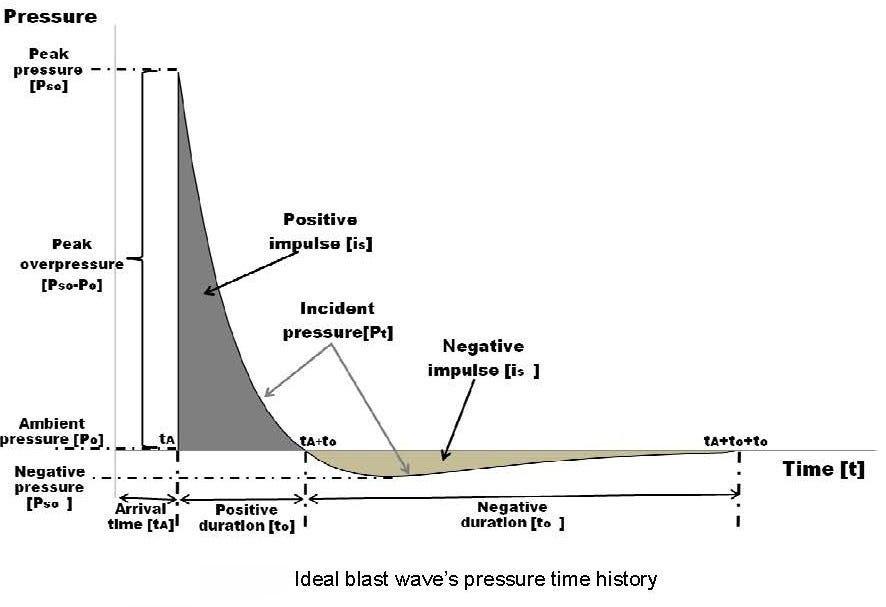





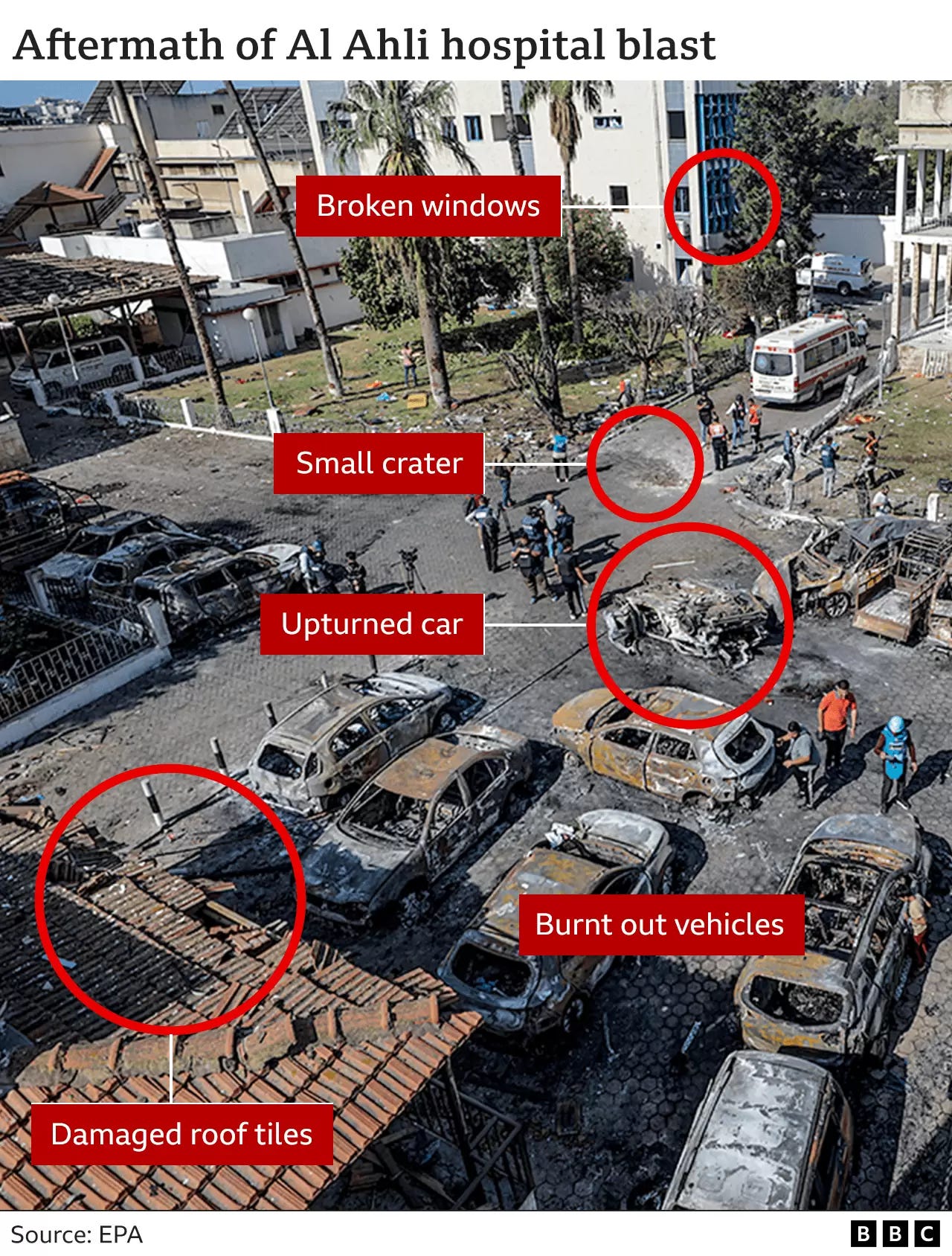
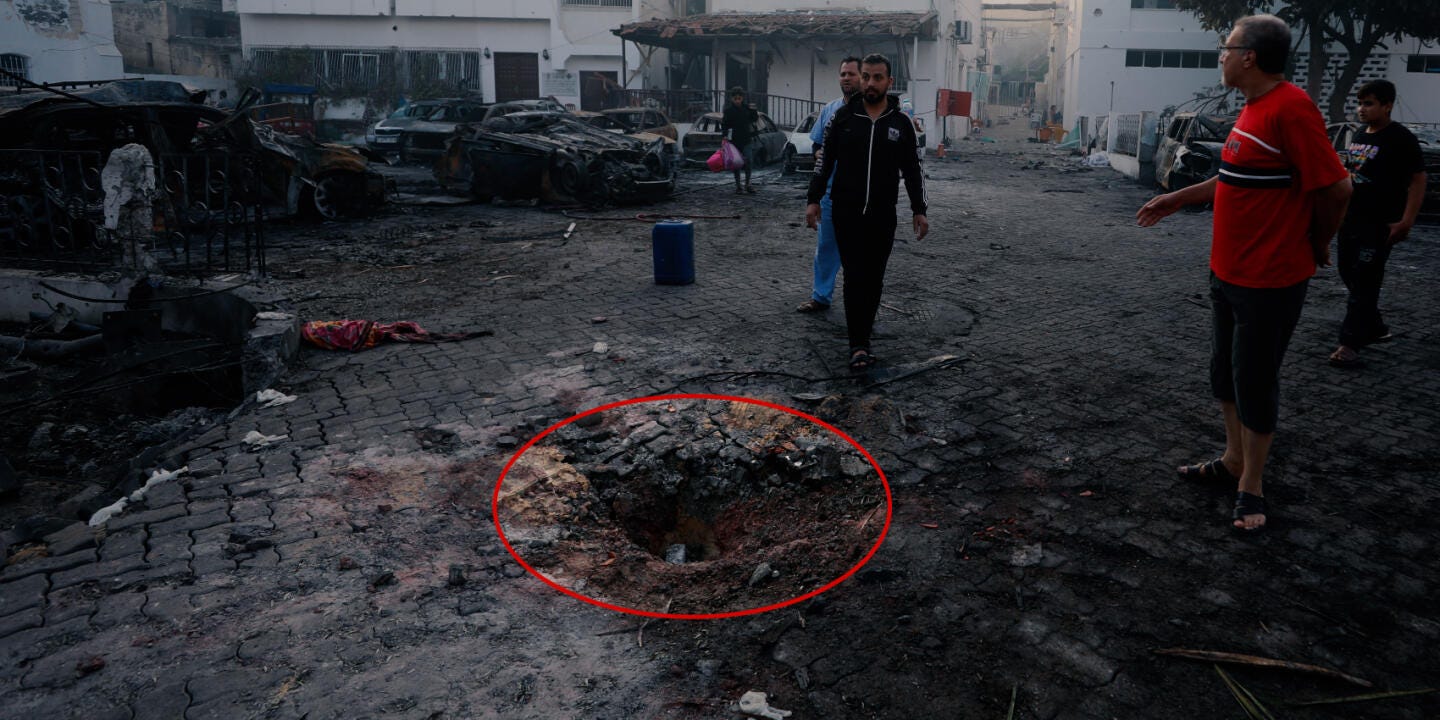

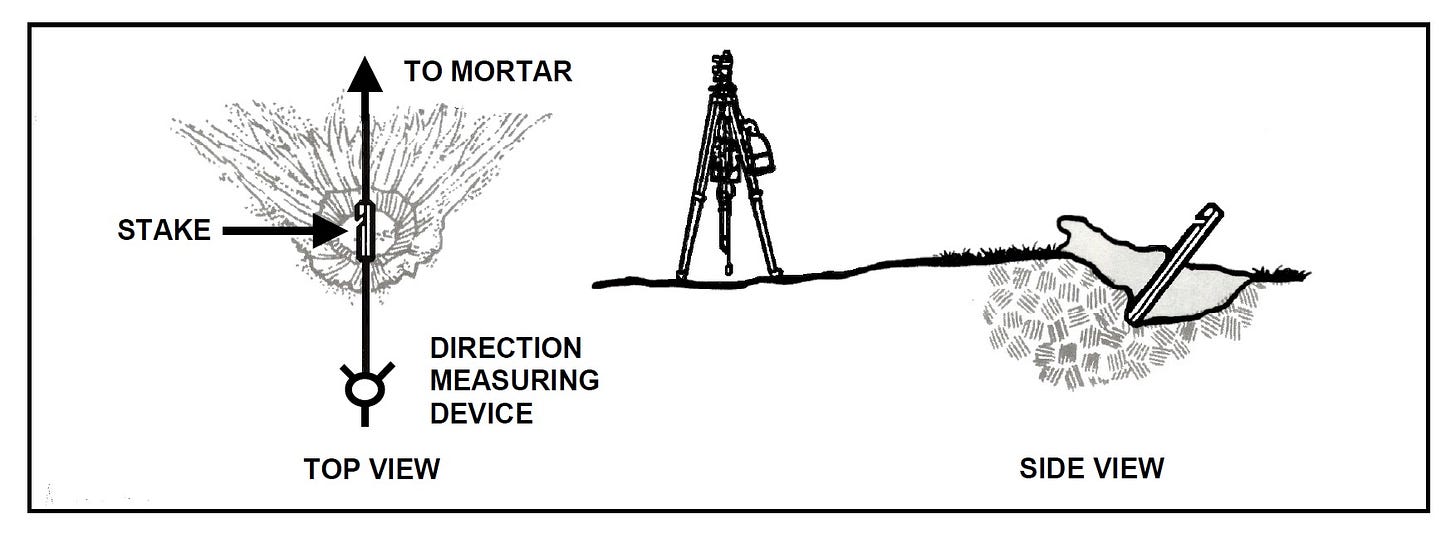
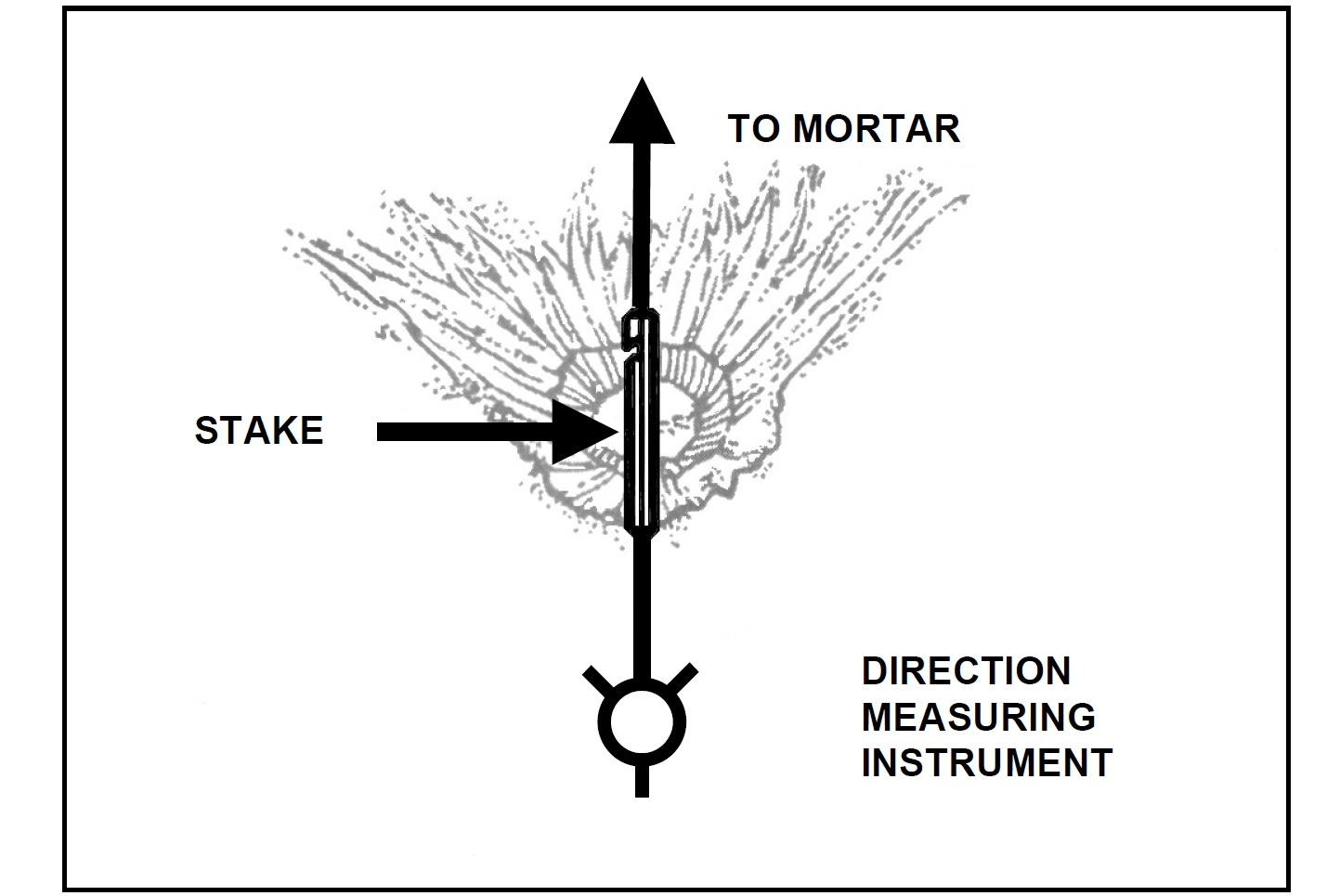
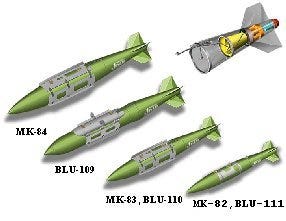
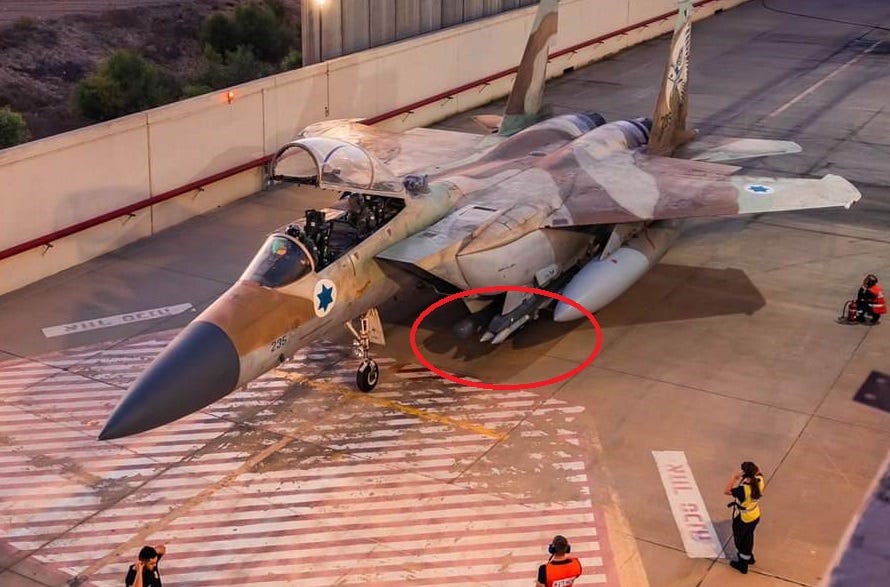
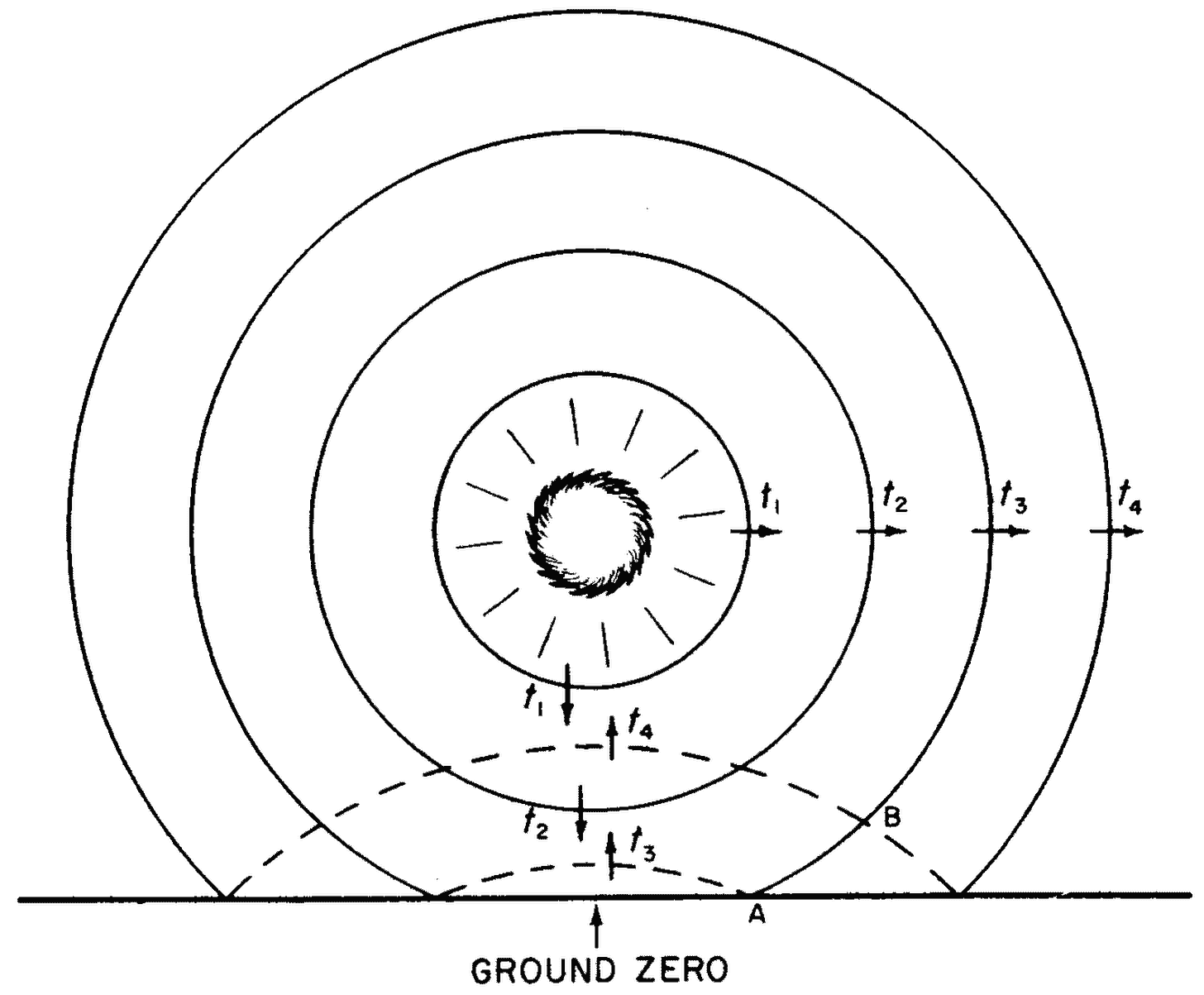





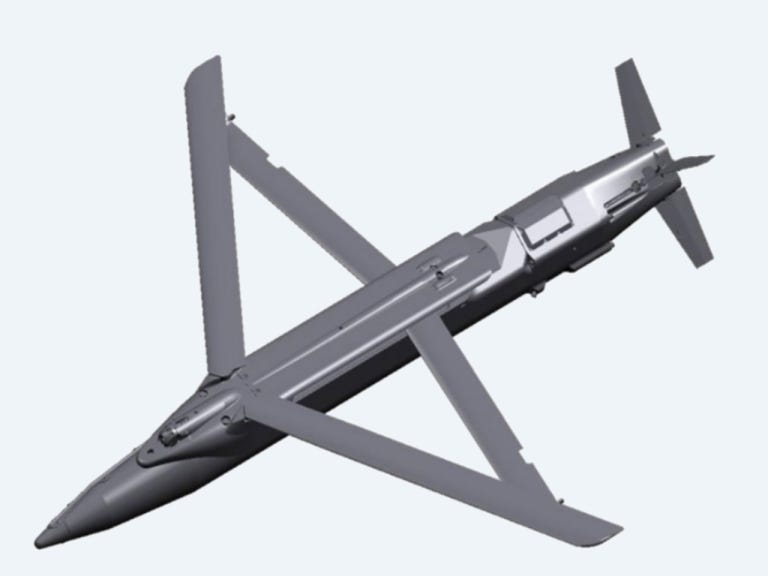


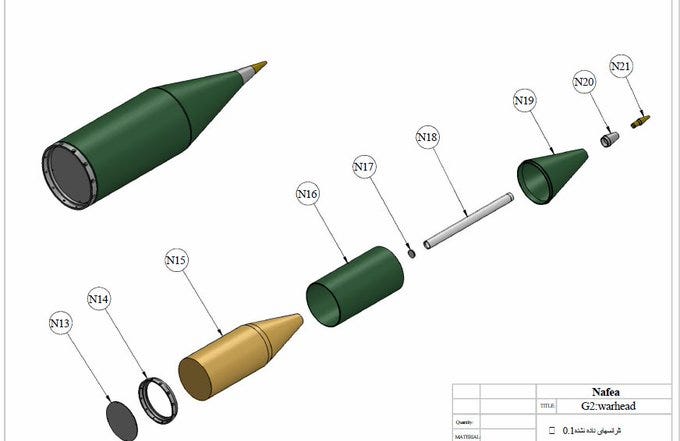


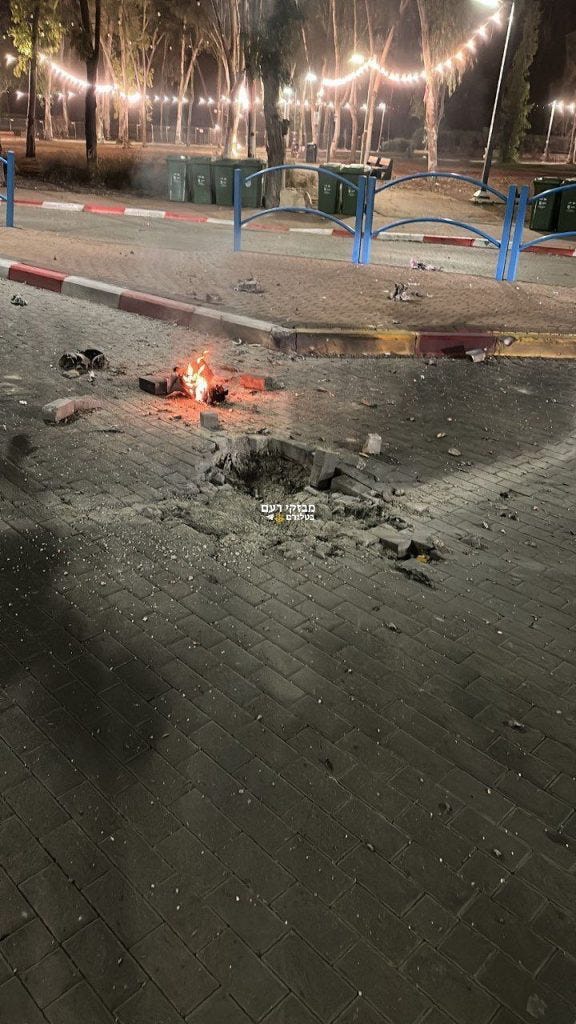
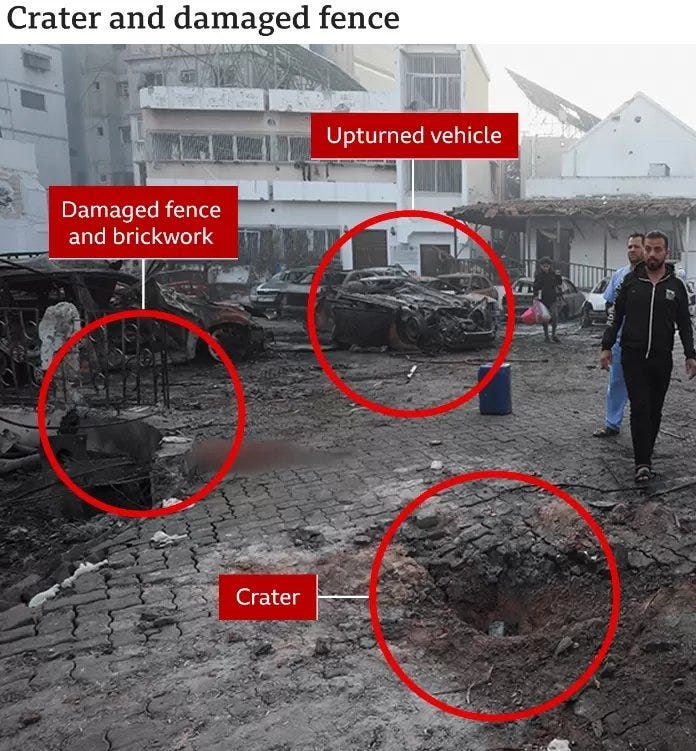


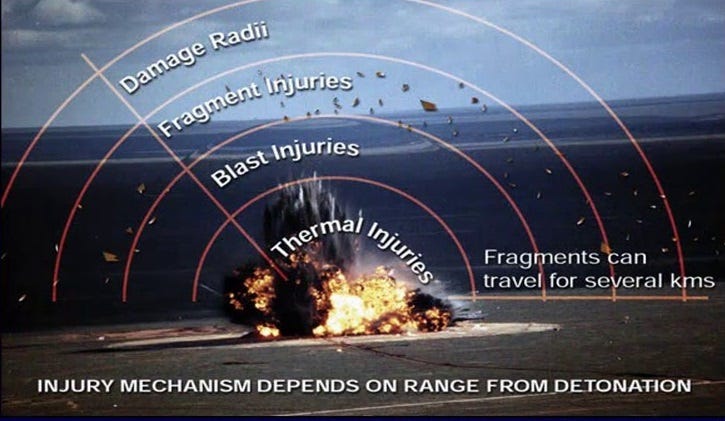


Thank you very much, Mike! I owe you one!
What I know is 3 Israeli sources immediately claimed responsibility:
* High level Netanyahu spokesperson (forget his name, but screen capture of his tweet is at Larry Johnson's blog & he later retracted it)
* IDF spokesperson tweet, just garage
* Israeli general ( forget name, but "Sisi" sticks in my head) also we did it, but just garage
Israel came out with 4 different stories:
1. We did it
2. We didn't do it, hamas rocket
3. We did it, but just the parking garage
4. It didn't happen hoax.
I therefore believe they did it, then panicked at level of devastation & row reaction.